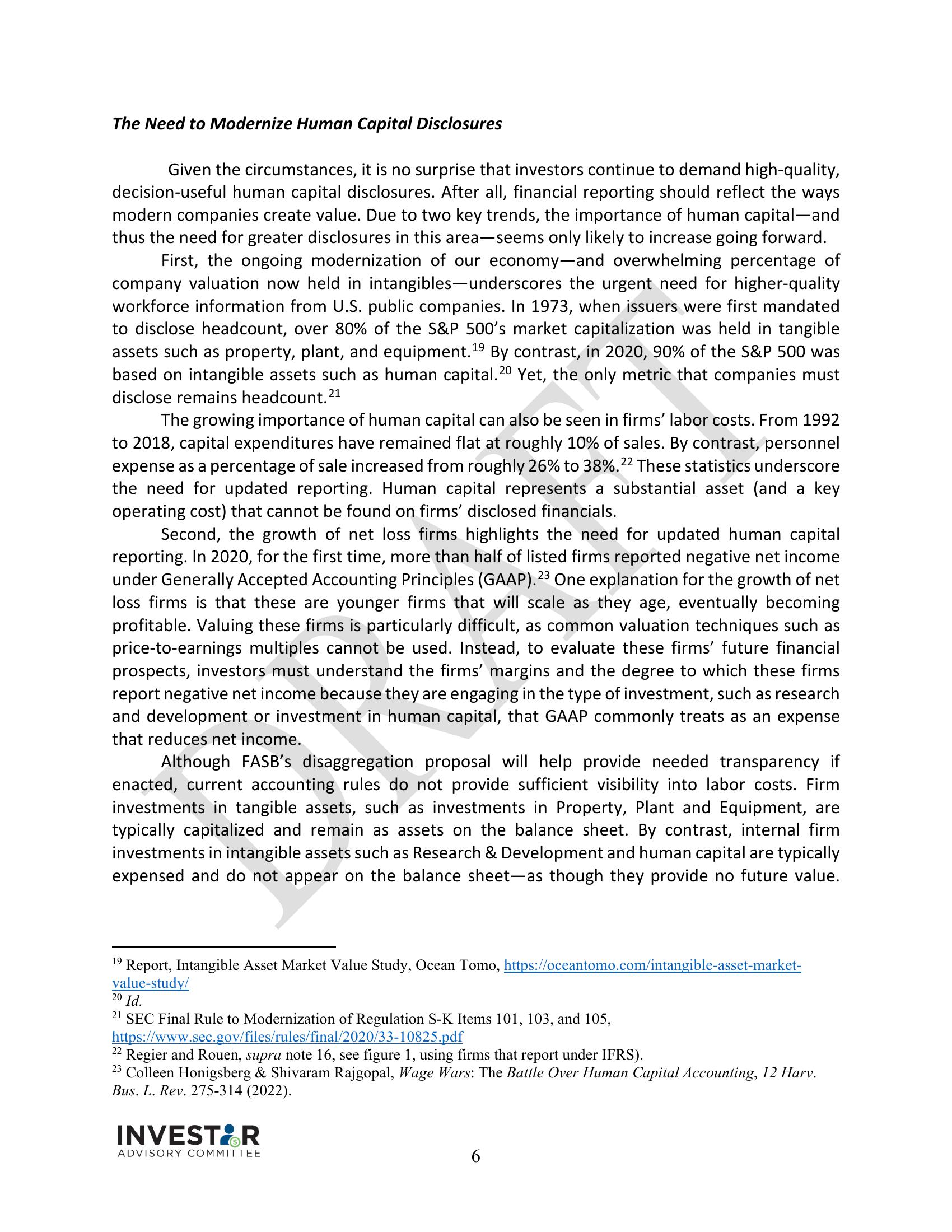Workforce Data Insight Pitch
The Need to Modernize Human Capital Disclosures
Given the circumstances, it is no surprise that investors continue to demand high-quality,
decision-useful human capital disclosures. After all, financial reporting should reflect the ways
modern companies create value. Due to two key trends, the importance of human capital-and
thus the need for greater disclosures in this area-seems only likely to increase going forward.
First, the ongoing modernization of our economy-and overwhelming percentage of
company valuation now held in intangibles-underscores the urgent need for higher-quality
workforce information from U.S. public companies. In 1973, when issuers were first mandated
to disclose headcount, over 80% of the S&P 500's market capitalization was held in tangible
assets such as property, plant, and equipment. 19 By contrast, in 2020, 90% of the S&P 500 was
based on intangible assets such as human capital. 20 Yet, the only metric that companies must
disclose remains headcount. 21
The growing importance of human capital can also be seen in firms' labor costs. From 1992
to 2018, capital expenditures have remained flat at roughly 10% of sales. By contrast, personnel
expense as a percentage of sale increased from roughly 26% to 38%. 22 These statistics underscore
the need for updated reporting. Human capital represents a substantial asset (and a key
operating cost) that cannot be found on firms' disclosed financials.
be the on
Second, the growth of net loss firms highlights the need for updated human capital
reporting. In 2020, for the first time, more than half of listed firms reported negative net income
under Generally Accepted Accounting Principles (GAAP). 23 One explanation for the growth of net
loss firms is that these are younger firms that will scale as they age, eventually becoming
profitable. Valuing these firms is particularly difficult, as common valuation techniques such as
price-to-earnings multiples cannot be used. Instead, to evaluate these firms' future financial
prospects, investors must understand the firms' margins and the degree to which these firms
report negative net income because they are engaging in the type of investment, such as research
and development or investment in human capital, that GAAP commonly treats as an expense
that reduces net income.
Although FASB's disaggregation proposal will help provide needed transparency if
enacted, current accounting rules do not provide sufficient visibility into labor costs. Firm
investments in tangible assets, such as investments in Property, Plant and Equipment, are
typically capitalized and remain as assets on the balance sheet. By contrast, internal firm
investments in intangible assets such as Research & Development and human capital are typically
expensed and do not appear on the balance sheet-as though they provide no future value.
19
Report, Intangible Asset Market Value Study, Ocean Tomo, https://oceantomo.com/intangible-asset-market-
value-study/
20 Id.
21 SEC Final Rule to Modernization of Regulation S-K Items 101, 103, and 105,
https://www.sec.gov/files/rules/final/2020/33-10825.pdf
22
Regier and Rouen, supra note 16, see figure 1, using firms that report under IFRS).
23 Colleen Honigsberg & Shivaram Rajgopal, Wage Wars: The Battle Over Human Capital Accounting, 12 Harv.
Bus. L. Rev. 275-314 (2022).
INVESTOR
ADVISORY COMMITTEE
6View entire presentation